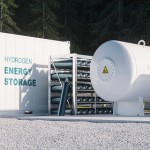The ongoing tensions between Russia and Ukraine have led to the prices of crude oil to shooting to $130/barrel, the highest the world has witnessed in over a decade. The rise in prices of oil, natural gas and fertilizers highlights India’s vulnerability to geopolitical sanctions. Green hydrogen is an emerging option that will help reduce India’s vulnerability to such price shocks. This was reiterated by Union Transport Minister Nitin Gadkari when he drove to parliament in a hydrogen-powered car.
Renewable energy (RE) technologies have four key deficiencies.
First, RE can only be generated intermittently. Battery technology cannot store electricity at a grid scale. In the last months of 2021, Europe was forced to buy natural gas at record high prices as renewable generation fell.
Second, there are question marks on the financial viability of green power. In India, renewable electricity is a replacement for coal-based power, the cheapest form of energy. That is a big constraint on its viability. Moreover, the customers of this power – the state distribution companies – are collectively insolvent. A business cannot prosper if its primary customers are financially unviable.
Thirdly, EV (electric vehicle) technologies have limitations. While electric cars and two-wheelers get a lot of visibility, much of India’s oil is burnt in heavy trucks. Lithium batteries are not viable for trucks.
Fourth, is the availability of critical minerals. Electric vehicles require large quantities of lithium and cobalt that India lacks. These minerals also have very concentrated supply chains that are vulnerable to disruptions. Large-scale investments in electric vehicles may create unsustainable dependencies for the country.
Intermittent hydrogen un the energy mix can help circumvent some of these problems. Hydrogen is an important industrial gas and is used on a large scale in petroleum refining, steel, and fertilizer production. India has a large and growing capacity base in all these industries. As of now, the hydrogen used in these industries is grey hydrogen, produced from natural gas.
Green hydrogen produced using renewable energy can be blended with grey hydrogen. This will allow the creation of a substantial green hydrogen production capacity, without the risk that it may become a stranded asset. This blending can start with petroleum refining, which is financially the strongest of the three industries, and then move on to steel and urea fertilizer. The high price of urea due to Russia-Ukraine conflict and its consequent impact on food security should also be factored in. Creating this hydrogen capacity will provide experience in handling the gas at a large scale and the challenges involved.
To widen the use of green hydrogen, it can be blended with compressed natural gas (CNG), widely used as a vehicle fuel in Delhi, Mumbai and some other cities. This will partly offset the need for imported natural gas and will also help flag off the challenges of creating and distributing hydrogen at a national level.
One challenge of using new transport fuels, whether CNG or electric vehicles, is the creation of large-scale refuelling networks. Bringing hydrogen vehicles on road too soon will result in creation of yet another set of infrastructure. Building fleets of hydrogen fueled vehicles for gated infrastructure can be a good starting point. Airports, ports and warehouses, for instance, use a large number of vehicles such as forklifts, cranes, trucks, tractors and passenger vehicles. Many, if not all, can run on hydrogen fuel cells. Each such application can use hundreds of vehicles, creating demand that will allow manufacturers to bring vehicles that can use hydrogen fuel cells into the market.
By bringing down the price of green hydrogen sufficiently, India can help unlock of some stranded assets. The country has close to 25,000 megawatts of gas-fired power generation capacity that operates at a very low-capacity utilisation level. The high price of natural gas reduces the viability of such electricity. These plants could use hydrogen blended with natural gas. Hydrogens could, however, be used to generate electricity after it has served its utility in other avenues.
To catalyse a hydrogen economy, India needs some specialist players to execute projects as well as finance them. In the past, large, new undertakings have been taken up by purpose-built companies. For example, ONGC, IOC and GAIL were set up for executing mega projects. They then became corporations. The CNG network in Mumbai and Delhi were created by MGL and IGL, and Petronet LNG was set up for creating India’s first LNG terminal. Establishing specialised companies with a clear focus has helped projects get off the ground, and this approach can be repeated for green hydrogen. However, the government participation in such a company must be capped at 50%.
Apart from government-backed players, the hydrogen economy will need private sector participation. India’s startup sector, with over 75 unicorns, is perhaps the most vibrant part of the country’s economy currently. This ecosystem has been enabled by a mix of factors, including the presence of entrepreneurs with ideas and investors who are willing to back up these ideas. Many start-ups have been able to find support from angel investors, venture capital and private equity backers. Involving this ecosystem in the hydrogen can be a powerful driver for growing this sector. Venture funds and private equity funds specifically focused on green hydrogen could make it easier for new entrepreneurs with ideas to get funding and achieve scale.
The Government’s Green Hydrogen Policy sends the right signals about its intent. It now needs to ensure that investment can freely come into this space.
This article was first published in Indian Express.
Amit Bhandari is the Senior Fellow for Energy, Investment and Connectivity at Gateway House. He is also the author of the paper, Achieving the Promise of Hydrogen for India and the World


